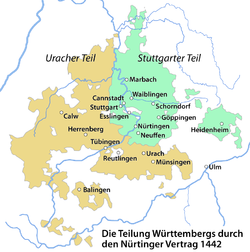- County of Württemberg
-
County of Württemberg
Grafschaft WürttembergState of the Holy Roman Empire ← 
1083–1495  →
→Division of Württemberg by the Treaty of Nürtingen Capital Stuttgart Language(s) Swabian German Religion Roman Catholic Government Principality Count - ca 1089–1122
(first count)
Conrad I- 1457–96
(last count)
Eberhard VHistorical era Middle Ages - County founded
by Conrad I
before 1081- Treaty of Nürtingen
divides county
1442- Treaty of Münsingen
reunites county
1482- Raised to duchy 1495 The County of Württemberg were a historical county with Stuttgart as its capital, formed by the territory of the House of Württemberg in the 11th century and then raised to Duchy in 1495.
History
In 12th century, House of Württemberg officialy acquired the county. With House of Hohenstaufen reign over Duchy of Swabia ended in 1250, territorial expansion conditions were developed. Ulrich I marriage in 1251 installed, the capital in Stuttgart. Ulrich III achieved further enlargements. In the victorious battle of Württemberg for Doffingen Count Eberhard II was on 23 August 1388 the power of the Swabian League cities break. Outstanding during the reign of Count Eberhard III. (Eberhard the Mild) (1392–1417) was the acquisition by the county of Montbeliard the vows for the later Count Eberhard IV on the 13th with Henriette of Montbéliard November 1397th
On 25 January 1442, Treaty of Nürtingen was signed between Ulrich V and his brother Ludwig I. This split Württemberg into two parts. Stuttgart's part went to Ulrich V and included (among others) the cities of Bad Cannstatt, Göppingen, Marbach am Neckar, Neuffen, Nürtingen, Schorndorf and Waiblingen. Bad Urach's part went to Ludwig I and included (among others) the cities of Balingen, Calw, Herrenberg, Münsingen, Tuttlingen and Tübingen. The County of Montbéliard, after the death of the mother of the two counts, Henriette on 1444, added to Bad Urach's part.
With the agreement of 14 Münsinger December 1482 and the Treaty of 2 Esslinger September 1492 succeeded the Count of Württemberg-Urach and later Duke Eberhard the Bearded, remove the split Württemberg again. The childless Eberhard became the sole ruler of the reunited country. The successor was the reigning Count of Württemberg-Stuttgart Eberhard VI. determined that the country should govern together but with a committee of twelve from the so-called respectability, the representatives of the noble and non-noble estates in the country.
Categories:- Wikipedia articles needing cleanup after translation
- Former principalities
- Former countries in Europe
- States of the Holy Roman Empire
- States and territories established in 1083
- States and territories disestablished in 1495
- Württemberg
- House of Württemberg
- 11th-century establishments
- States and territories established in 1482
Wikimedia Foundation. 2010.


